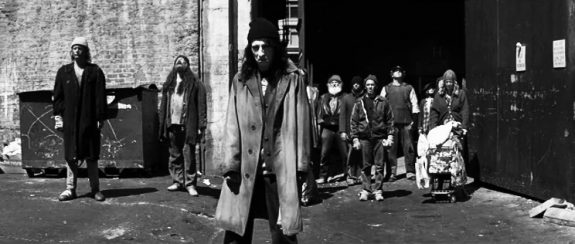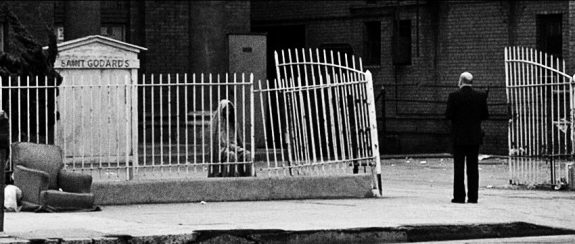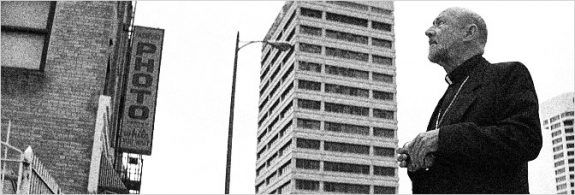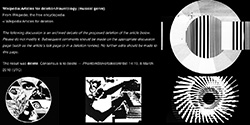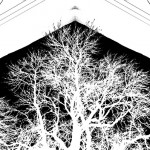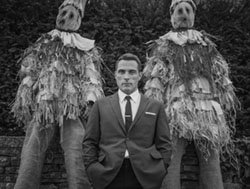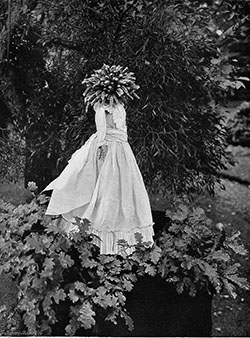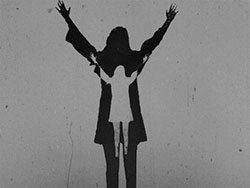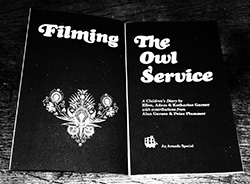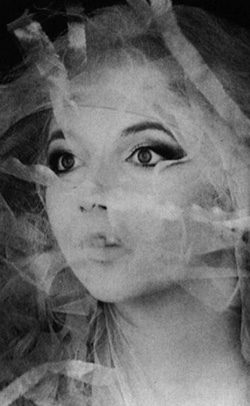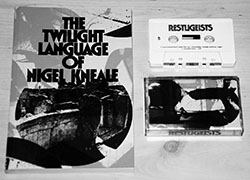In the posts A Lineage of Spectres (Part 1 and Part 2) I mentioned how hauntology and some related work could be seen as a form of exploring or creating modern-day magic, the mystical, the supernatural, spectres and hauntings… which brings me to John Carpenter’s 1987 film Prince of Darkness.
I first watched Prince of Darkness a number of decades ago and I always remembered it as having a haunting after effect, one that in part was caused by the way in which it played with and interwove horror shocks and tropes and an alternative scientific exploration/explanation of religious archetypes which was left not fully explained or resolved and which allowed the mind to wander (and worry).
Well, where to start with this film. It is so culturally and theoretically layered that I could well be writing for the rest of the year.
First off, some background to the production of the film, a summary of the plot and some its themes…
(Warning: the following contains spoilers.)

(John Carpenter on set with Victor Wong and Donald Pleasance.)
After having worked on a number of larger budget studio films and being involved in the various conflicts and compromises that can come with such a way of funding and working, John Carpenter made Prince of Darkness as a relatively low budget film, in part as a way in which he could keep control of the story, his vision and the final resulting film.
Although low budget, this is not a typical b-movie horror film but rather it has an intriguing scientific, theoretical and philosophical underpinning.
The film focuses on a group of university students, lecturer and researchers who are called in by a priest to investigate a mysterious container of swirling green liquid which organised religion has kept hidden for many centuries.
The liquid appears to contain or generate some form of energy force that is growing in strength and activity. The research group deciphers text found next to the cylinder that seems to describe the liquid as a corporeal, physical embodiment of the devil. The liquid appears to be sentient and is broadcasting increasingly complex streams of data.
Having setting up camp in a deserted church located in a desolate part of town where the container resides, they become trapped by threatening vagrants who seem to be part of a mob controlled by the liquid (the leader of whom is played by Alice Cooper) and its power begins to be unleashed, both psychically and literally when it escapes from the container and takes over members of the research group, leading to what could be considered forms of mind control, demonic possession and transformation…
I say could be considered as in part the film is an attempt to create a new story around the roots of evil, conjoining related religious belief with a form of scientific study, explanation and the possibility that not everything can be explained by science and rationalism.
(A sense of deserted streets was a recurring theme of John Carpenter’s films, one which often seemed to invoke a sense of isolation and lurking dread in the absence, stillness and the way that it implied being amongst but at a far remove from urban civilisation.)
As the film progresses the research group discover/theorise that the liquid may be an offspring of an even more powerful mass mind that controls all matter, one that is bound into an anti-matter realm or dark mirror image of our own universe.
This mass mind is a form of anti-God, an evil force as opposed to the benevolent omnipotent God in our own universe as had been taught and hoped for by religion:
“Suppose what your faith has said is essentially correct. Suppose there is a universal mind controlling everything, a god willing the behavior of every subatomic particle. Well, every particle has an anti-particle, its mirror image, its negative side. Maybe this universal mind resides in the mirror image instead of in our universe as we wanted to believe. Maybe he’s anti-god, bringing darkness instead of light.” (From Prince of Darkness.)
Within the film’s plot the knowledge that “evil” has a literal physical form is said to have been known but hidden and suppressed by small subterranean sections of religion/the church for millennia, while the wider church chose to present evil as a more metaphysical concept and hence the guarding or hiding of this container.
This “body of evil” has also lain dormant for millennia but the film depicts its awakenings and attempts to reinstall its power in this universe and to bring its “father”, the more powerful dark force, from the mirror image or anti-matter world into our own. As mentioned previously it attempts this by taking over humans in a number of ways, psychically controlling human minds and actions and/or physically invading, transforming and possessing bodies.
(Donald Pleasance plays slightly against type in the film, taking the part of a possibly weak willed priest who appears to crumble as the threats unfold and who when told of the above possibilities in connection with the physical source and embodiment of evil gently, softly and almost plaintively says “Why weren’t we told the truth… only the corrupt are listened to now and they tell us what we want to hear”.)
Throughout Prince of Darkness members of the research group have the same dream of a shadowed figure emerging from the front of the church where they are based, dreams which seem to be nearer to transmissions than normal dreams and which have some of the aesthetic signifiers of a semi-broken analogue television signal – scanlines, crackles, interference etc.
Aside from the more conventional horror tropes and aesthetics in the film, it is in these sections in particular that the film has an unsettling and intriguingly unexplained atmosphere: they seem to be a warning or visions of a dark future event which the viewers are instructed they must change or prevent but they have a fragmentary visual, audio and transmission quality, they appear to be broadcasts but are viewed only within dreams and throughout the film until its end the “broadcasts” are interrupted before their completion when the dreamer/viewer is awakened.
In part it is the films mixing and interweaving of the above strands, its exploration of religious and scientific theories, alternative possibilities and explanations that moves the film away from being a more conventional low budget “people trapped somewhere deserted as they fight supernatural forces” horror movie into an example of cinema when it is more explorative and can stretch and intrigue the mind and imagination.
Also at the time of the film’s making John Carpenter’s work seemed to benefit and thrive from the restrictions of a low budget which appeared bring out a sort of ragged, tight, sparse, almost street like energy to his work.
To be continued in Part 2…
Elsewhere:
The dream sequences from Prince of Darkness
Theorising
The trailer
Elsewhere at A Year In The Country:
Wanderings, Explorations and Signposts 4/52a: Halloween III: Season of the Witch – A Curious Slice of Culture and Collisions with the Past


